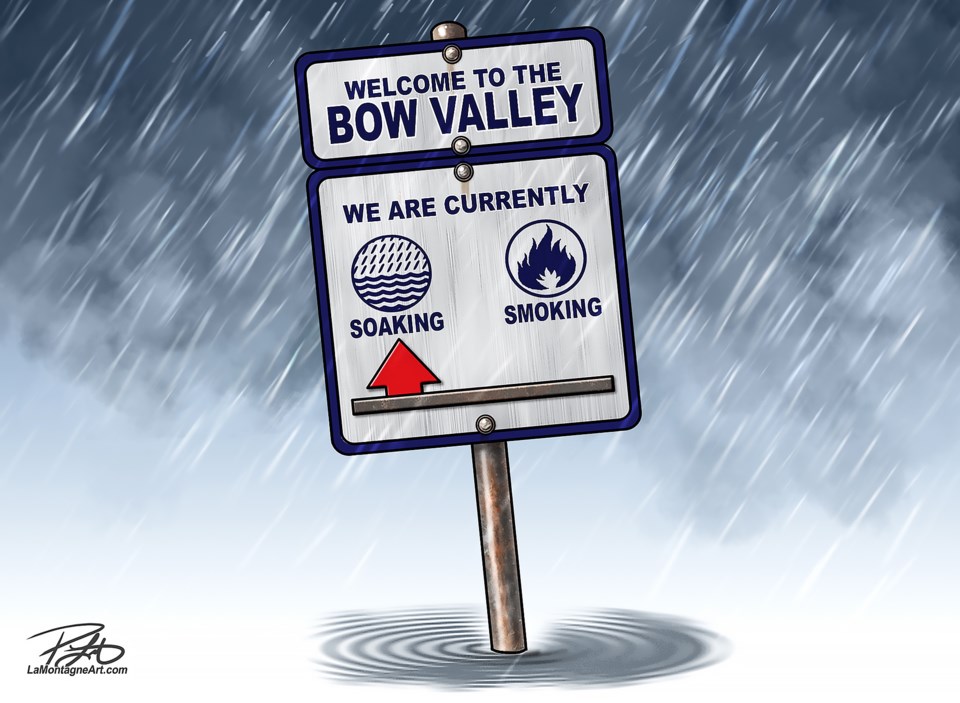The childhood rhyme of rain, rain, go away is the theme for southern Alberta and the Bow Valley.
Consistent rain pelted southern Alberta – including the areas of Banff, Canmore, the Municipal District of Bighorn and Kananaskis Country – that led to flood watches and warnings.
The seasonal monsoon June reared its head with rainfall beginning Sunday (June 12) and continuing through Wednesday (June 15). Environment Canada estimated a potential of 75-125 millimetres of rain would hit the region.
Both Banff and Canmore activated their emergency coordination centres to better prepare for any possible emergency scenarios that could’ve arisen. But while the annual June rain blanketed the region, it further highlighted the risk water brings in drastically impacting human life and economics in a community or region.
Though significant flooding was thankfully not seen, the 2013 floods left an indelible mark on residents and it shows the annual concern flooding can bring to the Bow Valley.
The 2013 floods had five people die and roughly $6 billion in damage after more than 200mm of rain fell in three days. Those floods particularly devastated the Bow Valley, which has since left communities on high alert each spring as the rains hit the region and snow melts.
Since 2013, millions have been spent on flood mitigation work on projects such as Heart, Exshaw and Jura creeks in the Municipal District of Bighorn. In Canmore, the Mountain Creek Hazard Mitigation program has projects planned, completed or continuing for Cougar Creek, Peaks of Grassi, Echo Creek Canyon, Pigeon Creek, Stones Canyon Creek, Three Sisters Creek and Stoneworks Creek.
But the risk of flooding rears its ugly head across the country and will continue to increase as climate change impacts the world.
An investigation by CBC Marketplace in 2021 noted only six per cent of Canadians living in a designated flood risk area knew they lived in such an area. It found a lack of floodplain mapping and sketchy real estate rules further put homeowners in an unknown space.
The Insurance Bureau of Canada (IBC) warned in the same story six to 10 per cent of Canadian homes were uninsurable to flooding, which was likely to increase as insurance companies update risk assessments as climate change threats increase.
The 2021 British Columbia floods saw more than $500 million in insured damage, while the IBC estimated there was about $2.1 billion in insured damage from flooding last year in Canada.
A 2021 University of Waterloo report, Trending Water: Impact of Catastrophic Flooding on Canada’s Housing Market, found homes in communities that suffered catastrophic flooding between 2013-21 sold for 8.2 per cent less than the final sale price.
It also discovered about nine per cent – roughly 3.3 million people – live in one-in-100 floodplains, but that is expected to grow as climate change brings more environmental risks.
Among the report’s recommendations were updating flood risk maps, better guidance to homeowners to lower basement flooding risk, acting to mitigate and protect high-risk flood areas and identifying, retaining and restoring natural infrastructure such as grasslands and wetlands to limit flood risks.
The federal government launched a task force in 2020 to tackle at flood insurance and relocation – with flooding being the most common natural hazard. Those findings are expected this year.
However, changes in 2021 to Alberta’s Disaster Recovery Program – which aims to cover uninsurable losses – saw more downloading of costs to municipalities. It introduced a $500,000 cap and one claim per property, regardless of the owner.
Though the mitigation projects have shown their worth, the reality of flooding threat will only increase as climate change continues.
While massive floods were traditionally considered a once-in-a-lifetime occasion, the risk will continue on a near annual basis.




